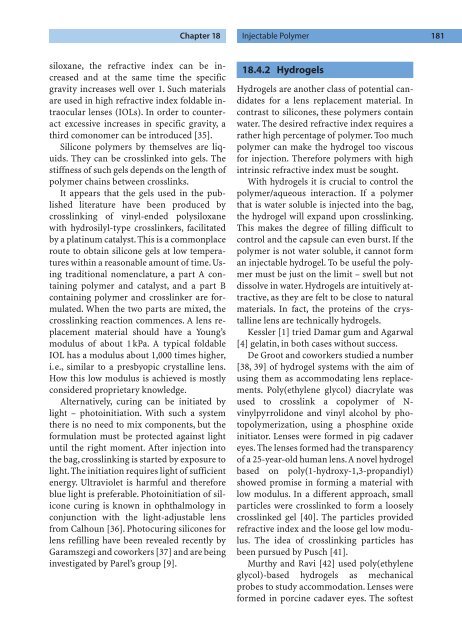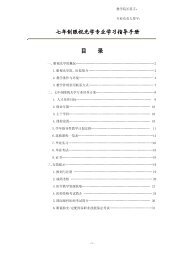Refractive Lens Surgery
Refractive Lens Surgery
Refractive Lens Surgery
You also want an ePaper? Increase the reach of your titles
YUMPU automatically turns print PDFs into web optimized ePapers that Google loves.
siloxane, the refractive index can be increased<br />
and at the same time the specific<br />
gravity increases well over 1. Such materials<br />
are used in high refractive index foldable intraocular<br />
lenses (IOLs). In order to counteract<br />
excessive increases in specific gravity, a<br />
third comonomer can be introduced [35].<br />
Silicone polymers by themselves are liquids.<br />
They can be crosslinked into gels. The<br />
stiffness of such gels depends on the length of<br />
polymer chains between crosslinks.<br />
It appears that the gels used in the published<br />
literature have been produced by<br />
crosslinking of vinyl-ended polysiloxane<br />
with hydrosilyl-type crosslinkers, facilitated<br />
by a platinum catalyst. This is a commonplace<br />
route to obtain silicone gels at low temperatures<br />
within a reasonable amount of time. Using<br />
traditional nomenclature, a part A containing<br />
polymer and catalyst, and a part B<br />
containing polymer and crosslinker are formulated.<br />
When the two parts are mixed, the<br />
crosslinking reaction commences. A lens replacement<br />
material should have a Young’s<br />
modulus of about 1 kPa. A typical foldable<br />
IOL has a modulus about 1,000 times higher,<br />
i.e., similar to a presbyopic crystalline lens.<br />
How this low modulus is achieved is mostly<br />
considered proprietary knowledge.<br />
Alternatively, curing can be initiated by<br />
light – photoinitiation. With such a system<br />
there is no need to mix components, but the<br />
formulation must be protected against light<br />
until the right moment. After injection into<br />
the bag, crosslinking is started by exposure to<br />
light. The initiation requires light of sufficient<br />
energy. Ultraviolet is harmful and therefore<br />
blue light is preferable. Photoinitiation of silicone<br />
curing is known in ophthalmology in<br />
conjunction with the light-adjustable lens<br />
from Calhoun [36]. Photocuring silicones for<br />
lens refilling have been revealed recently by<br />
Garamszegi and coworkers [37] and are being<br />
investigated by Parel’s group [9].<br />
Chapter 18 Injectable Polymer 181<br />
18.4.2 Hydrogels<br />
Hydrogels are another class of potential candidates<br />
for a lens replacement material. In<br />
contrast to silicones, these polymers contain<br />
water. The desired refractive index requires a<br />
rather high percentage of polymer. Too much<br />
polymer can make the hydrogel too viscous<br />
for injection. Therefore polymers with high<br />
intrinsic refractive index must be sought.<br />
With hydrogels it is crucial to control the<br />
polymer/aqueous interaction. If a polymer<br />
that is water soluble is injected into the bag,<br />
the hydrogel will expand upon crosslinking.<br />
This makes the degree of filling difficult to<br />
control and the capsule can even burst. If the<br />
polymer is not water soluble, it cannot form<br />
an injectable hydrogel. To be useful the polymer<br />
must be just on the limit – swell but not<br />
dissolve in water. Hydrogels are intuitively attractive,<br />
as they are felt to be close to natural<br />
materials. In fact, the proteins of the crystalline<br />
lens are technically hydrogels.<br />
Kessler [1] tried Damar gum and Agarwal<br />
[4] gelatin, in both cases without success.<br />
De Groot and coworkers studied a number<br />
[38, 39] of hydrogel systems with the aim of<br />
using them as accommodating lens replacements.<br />
Poly(ethylene glycol) diacrylate was<br />
used to crosslink a copolymer of Nvinylpyrrolidone<br />
and vinyl alcohol by photopolymerization,<br />
using a phosphine oxide<br />
initiator. <strong>Lens</strong>es were formed in pig cadaver<br />
eyes. The lenses formed had the transparency<br />
of a 25-year-old human lens.A novel hydrogel<br />
based on poly(1-hydroxy-1,3-propandiyl)<br />
showed promise in forming a material with<br />
low modulus. In a different approach, small<br />
particles were crosslinked to form a loosely<br />
crosslinked gel [40]. The particles provided<br />
refractive index and the loose gel low modulus.<br />
The idea of crosslinking particles has<br />
been pursued by Pusch [41].<br />
Murthy and Ravi [42] used poly(ethylene<br />
glycol)-based hydrogels as mechanical<br />
probes to study accommodation. <strong>Lens</strong>es were<br />
formed in porcine cadaver eyes. The softest



